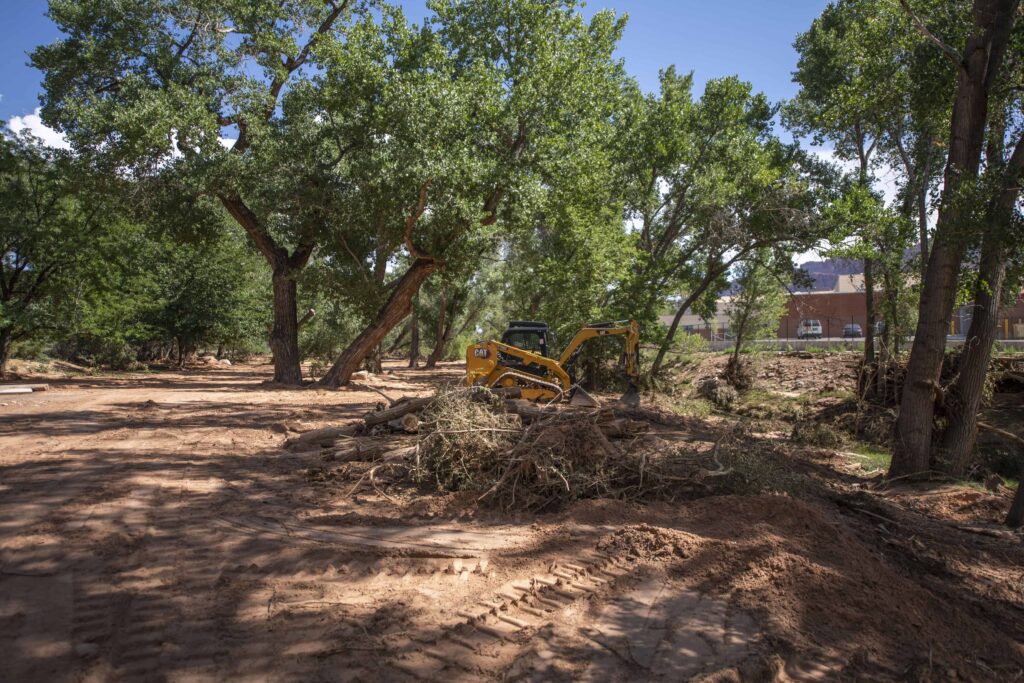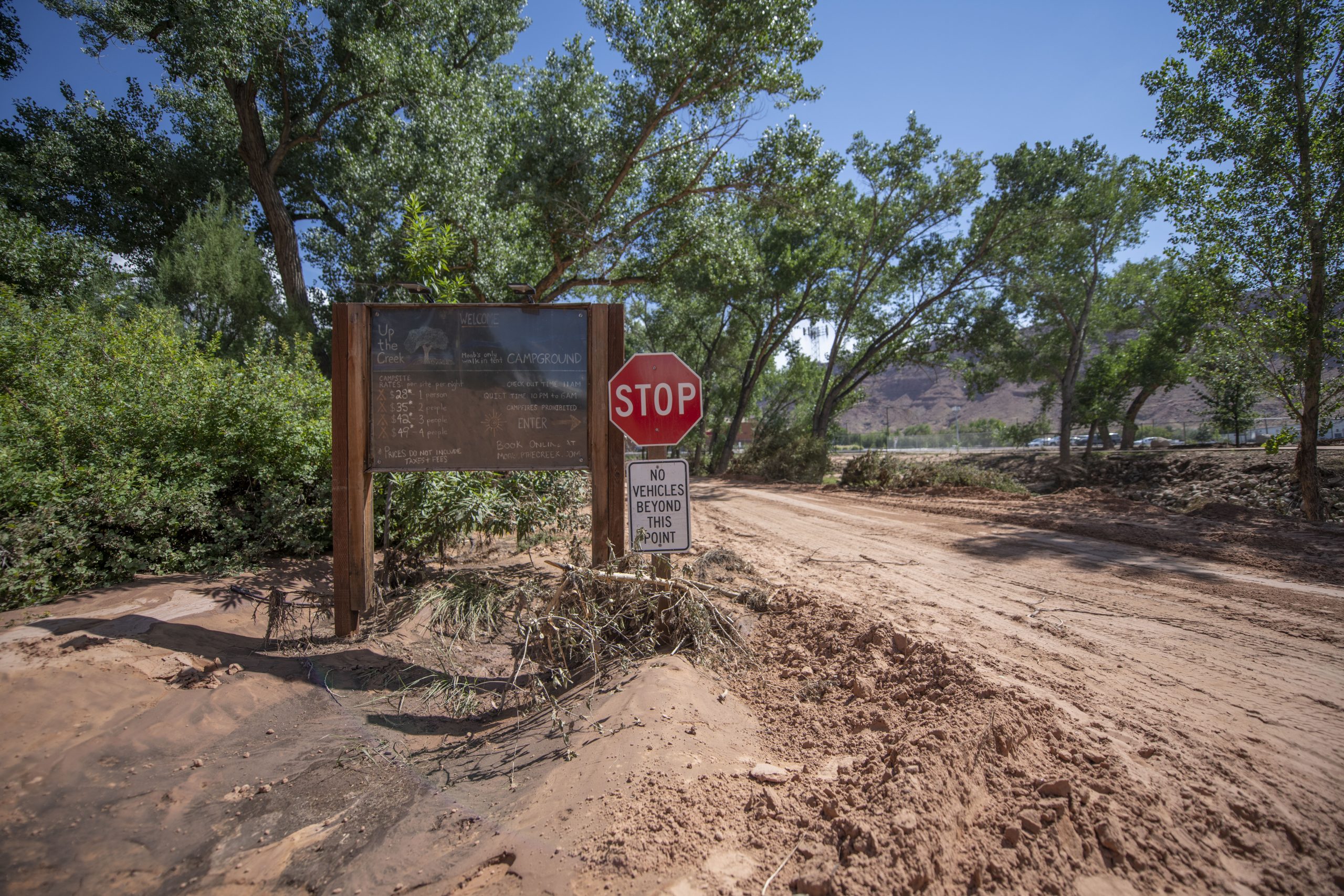Some information may be outdated.
Correction: A previous version of this article said the city and county had separate emergency alert systems; this is incorrect. The only emergency alert system in the area is managed by the county. The article also misidentified the county’s system, the county uses Alert Sense, not Notify Me. We regret these errors.
The night of Aug. 20, Brad Woodford was desperately trying to wake up everyone staying at Up the Creek Campground, an overnight tent-only campground that he owns with his wife Ariel Atkins. The campground is located on 300 S. along Mill Creek, just before the bridge. Around 9 p.m. that night, he decided to check if everything at the campground was alright—on his way there from his home about a mile away, he hit a red light in traffic and saw water flooding Main Street. As he pulled into the campground, Mill Creek was rising: the floodwater went from ankle deep to waist deep in a matter of minutes.
He remembers that one other camper was awake and shaking tents to wake everyone else up. He remembers the current pushing him downstream. He remembers watching large chunks of debris pound through the bushes bordering the campground, and he ran.
“If [the flood] had happened at 4 a.m. when people were asleep, I think we would have lost some lives,” Atkins said. 30 people were staying at the property that night.

The 100-year flood on the night of Aug. 20 revealed a major issue: Before, during, and after the flash flood, no push alert emergency warnings were issued by neither the city nor the county. Woodford and Atkins had to personally make the decision to evacuate the campground, which they almost didn’t do: Atkins said the rain that night wasn’t as bad as the rain had been during the two previous flash floods this year—based on her observations of the rain in town, she believed everyone would be okay.
During a city council meeting on Aug. 23, Mayor Joette Langianese and City Manager Carly Castle said they met with county staff the previous day to discuss the lack of emergency alerts that night. Anyone can sign up for emergency alerts through the county’s Alert Sense system. The county can also utilize a text-alert geofence, which would send an alert to every person within a set of boundaries—that could be used notify visitors of emergency situations, Castle said.
But on Aug. 20, neither system was utilized. Castle and Langianese said they had no clear idea why, and there’s still confusion among city staff, county staff, and emergency responders, as to how to utilize the system, and when to do so.
Langianese said both city and county staff agree: something needs to be fixed before the next emergency.
“This particular event was a huge eye-opener,” she said. “People could’ve died—I could’ve died, I was scared to death … and there was really nobody [saying what to do]. We were texting each other, trying to figure out what to do, but I felt really lost. I felt like there was nobody leading the show. And I think it really showed, very loudly, and very clearly, that we have really got to make some corrections in our emergency management response.”
She said the city and county staff formulated a number of working groups, one of which is dedicated to emergency response.
“We need to start planning for the future of [floods] continuing,” Langianese said.
Councilmember Jason Taylor said it’s frustrating that there are systems in place, and yet, in the face of an emergency, neither was used.
“It’s my understanding that during the last flood, people asked that this communication go out, and no one knew how to use the communication [technology],” he said. “It’s unacceptable. How do you tell someone whose kid just washed away in a flash flood that the dispatcher didn’t know how to work the system?”
Councilmember Rani Derasary said she signed up for the text emergency alerts years ago and has received very few texts—a sign to her that the system needs to be updated.
“It’s not complicated technology, and I do think our community deserves better,” she said. “It’s way past time to work together as a community to improve that … this isn’t acceptable. People almost died in the floodwaters. Even if you set off a siren in town to let people know something is going on, that’s better than nothing.”
Derasary said she’s “fed up” with bringing up the faults in the system.
“When something happens in town, you shouldn’t have to go check twelve Facebook pages and three Instagram pages and four websites to maybe find something out,” she said.
Woodford and Atkins are still debating whether or not to reopen the campground, Atkins said. They’re thankful for the community’s response—the morning after, Scott and Lori McFarland from High Point Hummer were digging buried cars out of the campground’s parking lot, along with other volunteers—but they’re unsure of what to do now.
“Unless we can ensure the safety of our campers, we don’t want to reopen,” Atkins said. She’s worried that future monsoon seasons will become more severe, and she’s worried about the city’s infrastructure.
“It’s been so intense,” she said. “We’re trying to pause and be thoughtful about how we tackle this.”
Additional reporting by Maggie McGuire.
Appreciate the coverage? Help keep local news alive.
Chip in to support the Moab Sun News.






